Imagine: A game with awful tutorials, gameplay mechanics that can’t be enjoyed without proper explanations, some questionable character designs, and gacha mechanics. Despite what you might think, it’s one of my favorite games ever, but I think it’s going to take some explaining why…

Stormy skies ahead?
I know that title and introduction might seem a bit exaggerated, and perhaps it is to a small extent. But I really do mean it: I am amazed at how, despite all its shortcomings, Xenoblade Chronicles 2 manages to be an absolutely stellar game.
So…where to begin? I would say we ought to start at the beginning, but this is a 40+-hour-long JRPG, and I’m not getting this article out within the year if I summarize the whole game from start to finish. Instead, let’s split things up into categories. To avoid things getting bogged down with negatives and frustration, I’ll alternate between something bad and something good. Because let me be clear: while I have quite a few complaints, and this game is certainly flawed, I believe its positive aspects outweigh those flaws by an order of magnitude.
For context which may help explain some of the problems I will discuss: from what I understand, during the later phases of Xenoblade Chronicles 2‘s production, developer Monolithsoft was also assisting Nintendo with The Legend of Zelda: Breath of the Wild. This may have meant that their resources and staff were stretched thinner than they otherwise would have been, resulting in places where the game feels unpolished. Nevertheless, the game came out with these problems and even a few more that were patched or adjusted after release, so while I want to keep that development context in mind, it doesn’t invalidate these issues. For the purpose of this review, I’m discussing the game as it is after the final patch it received—version 2.1.0. I also won’t be covering any of the content in the DLC side story, Torna: The Golden Country, which actually fixes quite a few of the complaints that I will discuss; props to the developers for addressing things, even if only in the DLC expansion.
With all that said, strap yourselves in. This is a game I have a lot to talk about, so you’re in for a long one.
Bad: The Tutorials

Timely? Debatable. Explanations? Also debatable.
One of the major aspects of the Xenoblade Chronicles series is each game’s unique and varied mechanics. From combat to socializing to stat-building to equipment, many gameplay elements differ from what you might expect to find in a classic Final Fantasy or Dragon Quest game. Therefore, it makes sense that there should be instructions and guides in place to help explain all these complicated systems to the player. And Xenoblade Chronicles 2…certainly has tutorials.
Oh boy, does it have tutorials…
A common complaint I see in game reviews is frustration that a game features too many tutorials, or that they are too invasive. Alternatively, a game might be criticized for not having enough tutorials, or not providing enough information for the average player to actually understand things. Well, this game manages to fall prey to both of these issues. Its tutorials are many and frequent, even showing up in the last several chapters of the game. Not only that, quite a few of them are presented at inopportune times where their advice is not particularly helpful, or they might fail to mention important details to help you get the most out of that particular gameplay element. Occasionally the tutorials may even provide misleading or outright incorrect information! Here are a handful of examples to illustrate my point:
- The introduction to the “pouch item” system instructs you to purchase an item from a store that (unbeknownst to you) sells some of the least-useful pouch items in the whole game. To make it even more insulting, a store that sells much better pouch items, including one of the best pouch items in the game, is located nearby in the same town! These items make a huge difference to your combat effectiveness, and proper use of this mechanic can drastically speed up (or otherwise make easier) fights that might feel sluggish at times. This is a critically important problem to address in the early hours of the game, when a player forms their first opinions!
- Some tutorials follow up on previous ones within mere seconds. No, I’m not exaggerating. At least twice in the first few hours of the game, you finish reading a tutorial, take (almost literally) ten steps, and are stopped dead in your tracks by another tutorial! Really? You couldn’t have just consolidated them together, or separated them more so that each one happens at a reasonable time where it’s convenient for the player? They try to excuse it by saying “Whoops! I forgot to tell you something!”, but it just feels sloppy to me.
- The tutorial for the “Blade Arts” mechanic is meant to trigger when one occurs in combat, during a particular boss fight early in the game. However, Blade Arts trigger on a random basis, so if one never goes off during that fight… you don’t get the tutorial. And even if you do see it, it’s rather light on details.
The list goes on, but most of them are similar to what I’ve already mentioned here. And to be clear, most of the tutorials are perfectly fine. Or at least, they would be if it weren’t for one final, glaring design flaw: you cannot review the tutorials after you’ve seen them. Accidentally button-mash through part of a tutorial message in the heat of battle? Put down the game for a few weeks and forget how something works? Sucks to be you, because aside from reloading a previous save point (if you even can; the game only has one save file per player), there is no other way to review the tutorials unless you want to start a new game from the beginning. This is particularly egregious because the first Xenoblade Chronicles game not only had a dedicated menu to review tutorials, but many of them were offered via a simple optional button prompt at the side of the screen, rather than forcibly halting the pace even if you were already familiar.
I might call these tutorial problems the game’s greatest failing. A failure to teach the player your own mechanics—especially in such a complex game with so many moving parts—is a sin of game design in my opinion. It feels like the person writing or implementing the tutorials did not have very good communication with the people who had actually designed the systems being explained.
Good: The World Design and Graphics
While I took many of these featured screenshots explicitly for this review, plenty of them were taken organically when I felt particularly stirred by the scenery around me or the view off in the distance. While I sadly cannot pair the images with the original music track that was playing at the time for fear of being erased by Nintendo’s legal team, that’s just one more thing that makes this game an absolute joy to behold. But I digress. Monolithsoft are absolute masters of their craft, and I am very frequently staggered that they were able to make this game run as well as it does—while looking as good as it does—on the relatively underpowered Switch hardware.
A trademark of the Xenoblade Chronicles series is broad regions with varying terrain height, climate, and geography; moreover, landscapes that stretch off into the distance, beckoning you to explore. The first game on Wii was an impressive showcase, featuring extremely long draw distance and smart area design: the landscape truly did stretch out as far as you could see! The two giant regions of the Bionis and Mechonis featured a variety of climates and terrain styles, from caves to marshes to grasslands to badlands to factories, all of which interweaved into the larger whole of the “titan” they were located on. I’m happy to report that Xenoblade Chronicles 2 is similarly impressive. The game takes place in the world of Alrest on multiple “titans” floating in a beautiful sea of clouds. Each titan serves as a pseudo-continent and has its own unique visual and geographical identities. (Click on any of these image groups below for a full-screen view!)
First up, the Argentum Trade Guild ship “Goldmouth” is effectively a small city strapped to a blimp-like flying titan. Since the whole community is basically run by Nopon, it naturally features the Nopon architectural style of red and brown wood with metallic trim. It’s an entirely artificial and practical construct, so it doesn’t feel very large in scope outside of its crowded trading plaza and mezzanine. It has many catwalks and tight corridors, as well as a few places to look out over the vast cloud sea.
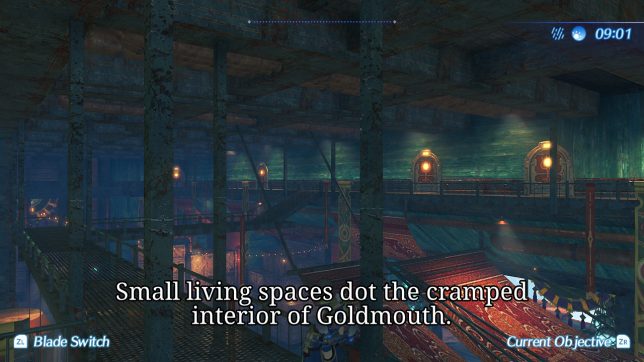
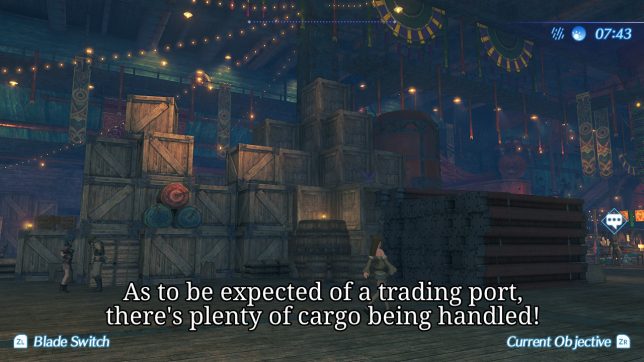

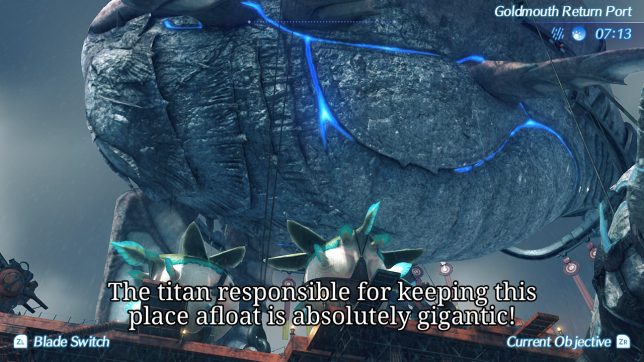

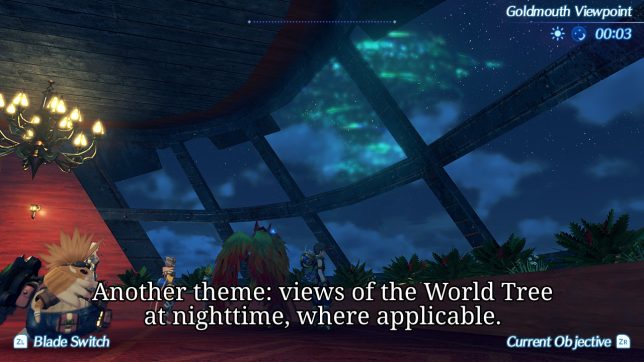
The region of Gormott features not only lush, hilly grasslands, but also a dark, tropical forest. Trees dot the landscape: some average-sized, some absolutely huge, reaching easily several hundred feet tall. On the wide-open plains, you can spot a large variety of wildlife about in the sky and on land. On some days, you may bear witness to impressive thunderstorms; a personal favorite weather type of mine—even if I wouldn’t want to be going out on an adventure in it.
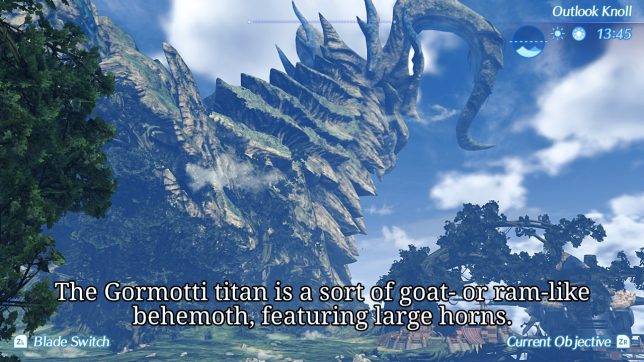

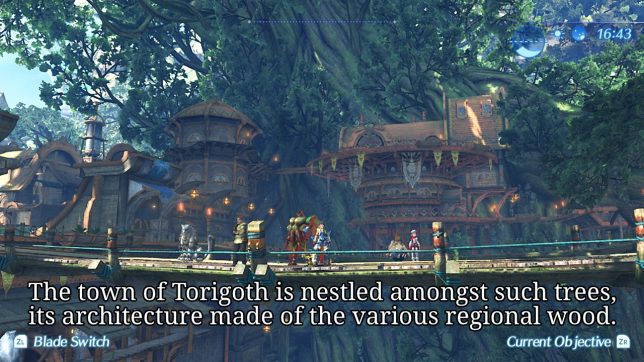
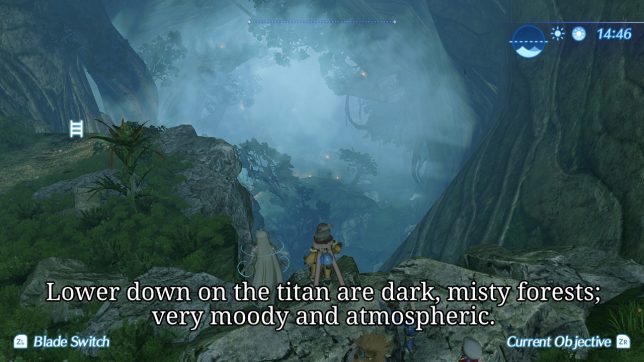
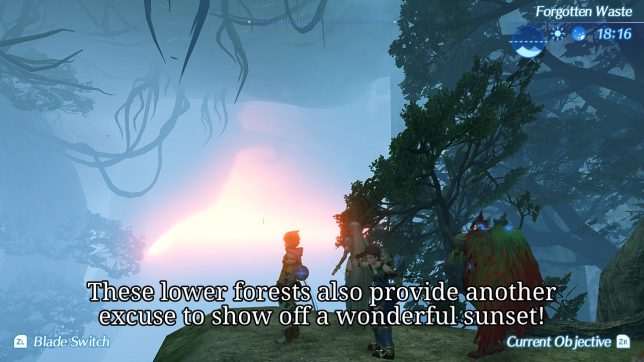
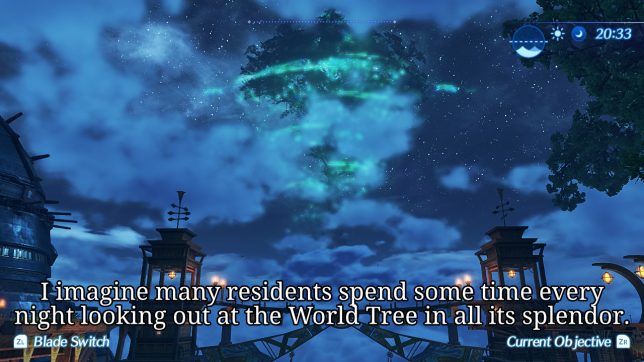
The land of Uraya exists completely inside its titan’s body rather than outside. It features a combination of small cave-like passages and wide-open caverns with light filtering in through the creature’s translucent hide. The local phosphorescent Saffronia trees glow a beautiful shade at nighttime, ranging from reddish-orange to pink. A unique weather type on this titan is a sparkling hailstorm; absolutely gorgeous to behold.
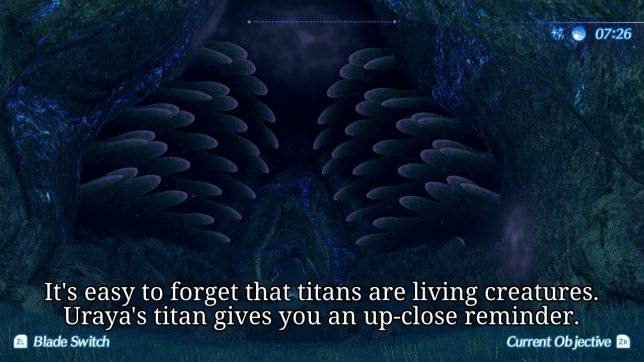
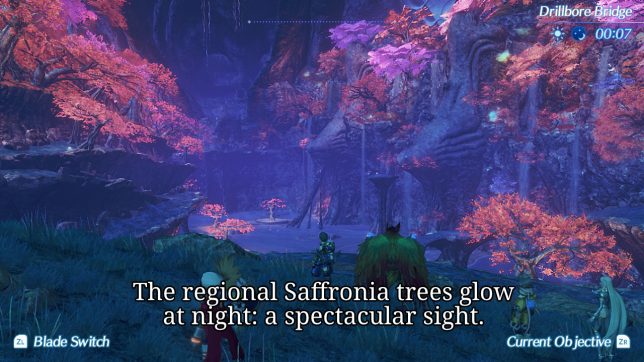
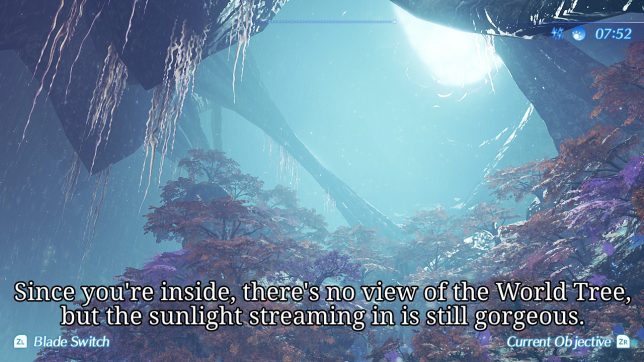
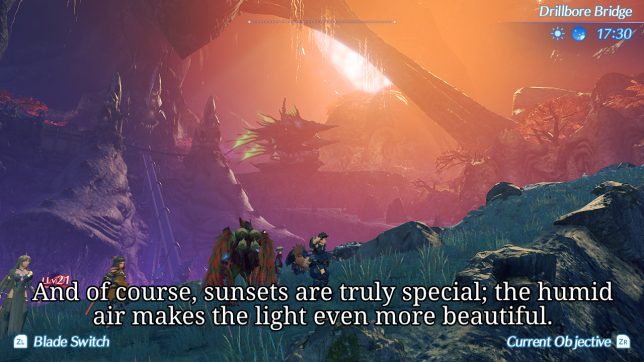
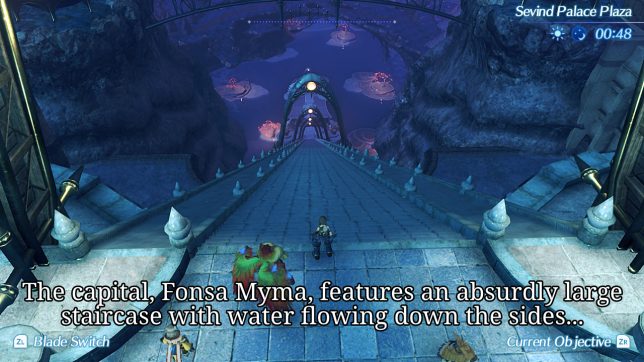

The heavily-industrial titan of Mor Ardain shows the Ardanian people’s cultural reliance on technology quite clearly. Blackened steel structures, large pipes, and other huge mechanisms cover the dry, rusty rock of the titan’s body. Due to the titan’s naturally hot climate, vegetation is scarce, and instead the government’s focus is on using their strong manufacturing industry and their technology’s ability to harness the abundant sources of thermal energy from the titan. A unique weather type here is the dust storm: fitting, and certainly atmospheric. (Also, the music in this area, called “Roaming the Wastes”, is one of my favorite songs in the game!)
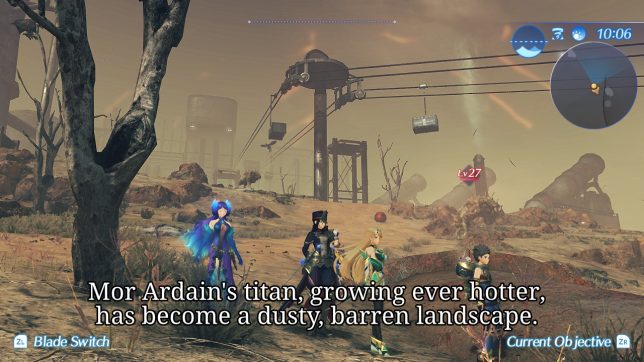
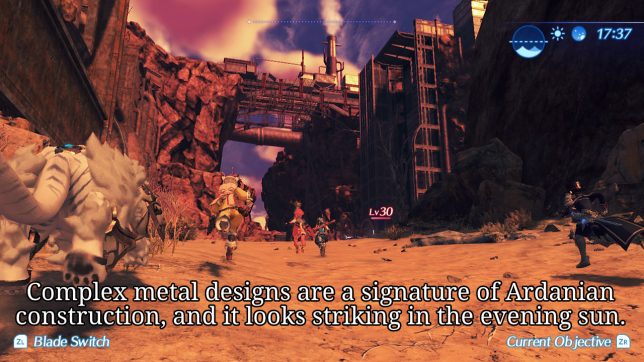

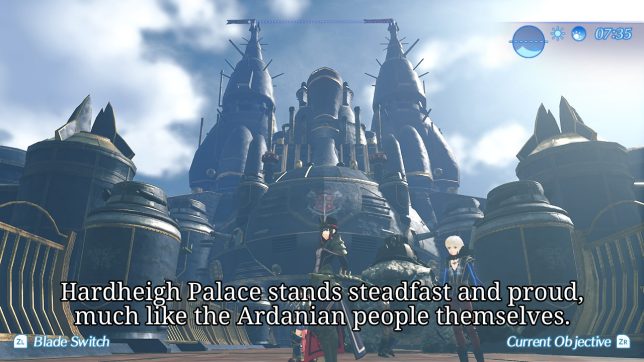


The Leftherian Archipelago is nestled around a strange “mountain” in the cloud sea with an enormous unseen titan inhabiting the very center. Smaller jellyfish-like titans are chained together in winding bridges a hundred feet in the sky. The terrain is a mix of pearly-white sands, lime-green grass, purplish rock, and turquoise waters.

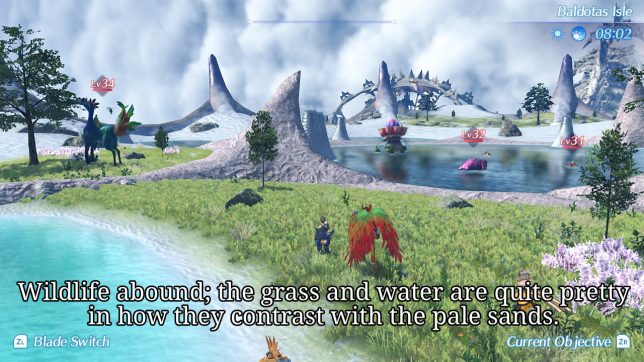
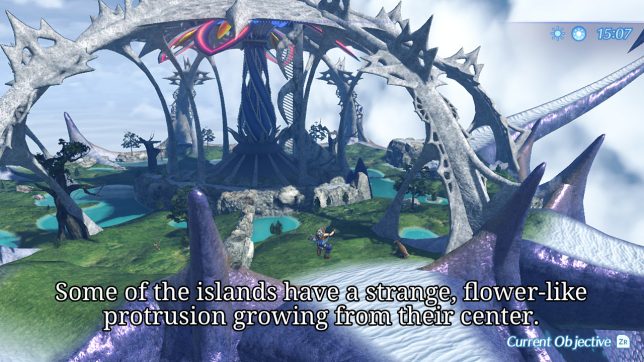
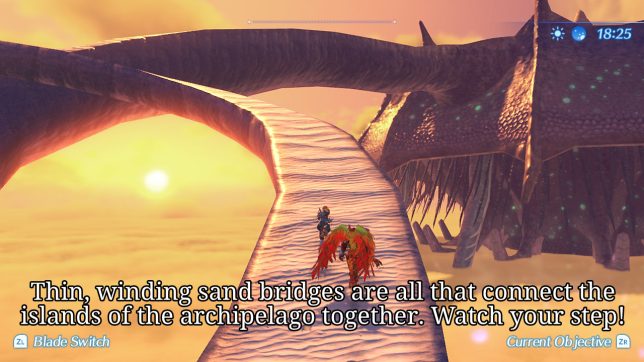
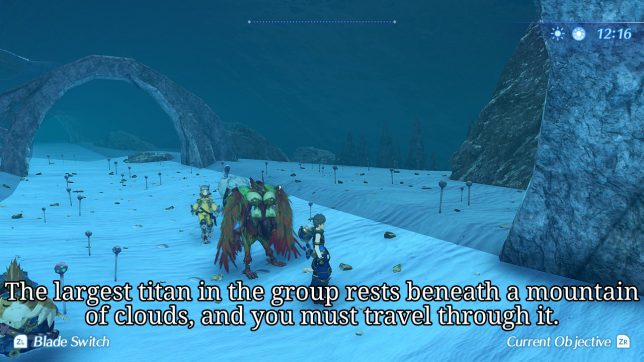
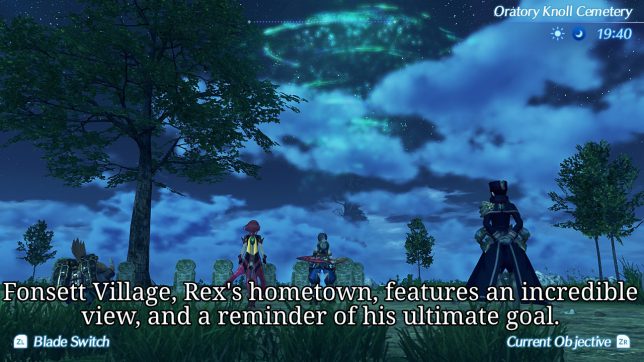
The Indoline Praetorium is a very small aerial titan featuring a holy sanctum dedicated to worshiping the Architect: the divine being who created Alrest and resides in the sacred land of Elysium within the World Tree. The buildings and plaza feature bluish roofs and lots of impressive white-and-gold stone columns and walls. Many pious folk mill about the area, and a large homeless shelter occupies a great chunk of the space below the marketplace.
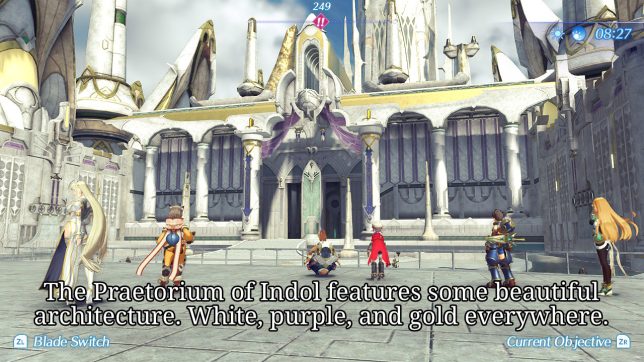



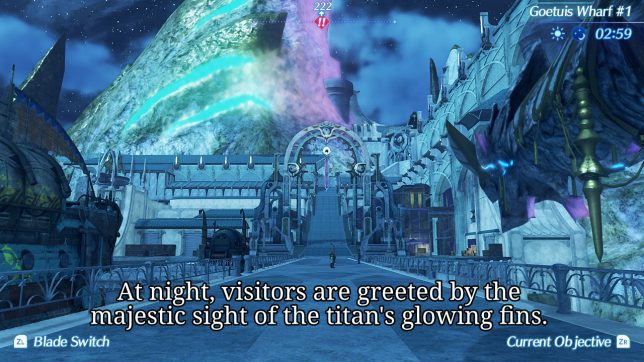
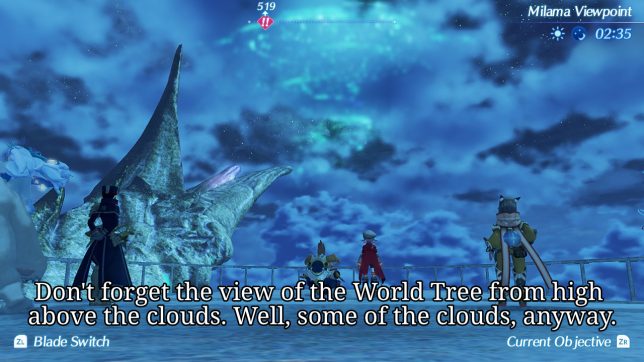
Inside the frigid titan Genbu, the nation of Tantal is a snow-covered expanse spanning as far as the eye can see. Featuring a vast and surprisingly vertical landscape, the place looks gorgeous during the day and night. Its capital city—Theosoir—has seen better days; the consequences of their complete isolation from the outside world.

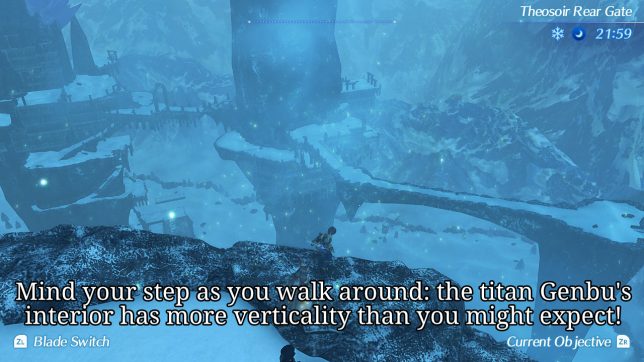
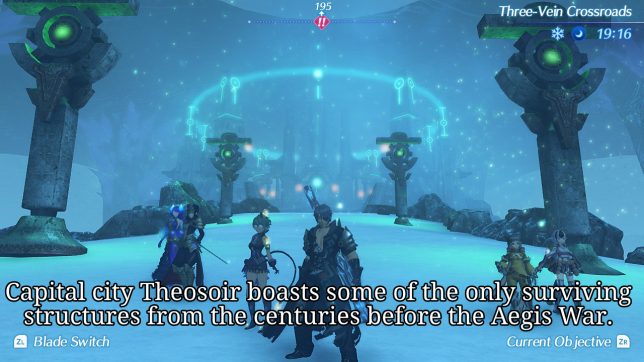
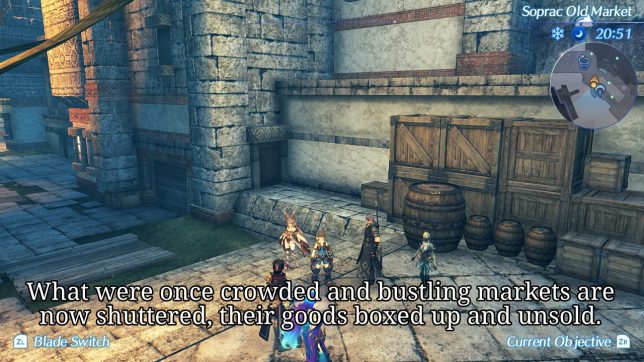


There are several more locations to visit in this game, and the ones I’ve shown here are vast and worthy of a complete exploration; these are just the highlights.
Regarding the game’s graphics, there are certainly concessions that had to be made. A couple of areas don’t run at a steady 30 fps, and the game uses a rather primitive form of temporal anti-aliasing, which can cause objects that move rapidly—or stationary objects adjacent to rapidly moving scenery—to appear “smeared” on the screen. This can be a bit distracting at times, but is a problem that crops up only rarely and never during cutscenes or other important story moments as far as I can tell. One of the reasons they needed such a strong anti-aliasing technique is because the game’s 3D graphics render at a rather low resolution, and are scaled up to match the resolution of the 2D elements and UI.
However, the game’s stylized presentation helps ensure that this game looks appealing even when there’s not quite as many pixels as one might hope for. That being said, while I think the screenshots I’ve presented in these galleries look pretty good, the game is going to look even better in motion while you’re playing it. Though I do love games that can accomplish a high-resolution, photo-realistic graphical style, I think that Xenoblade Chronicles 2‘s art style and presentation holds up well, and I predict it will continue to age gracefully in the coming years.
Kinda Bad: The “Gacha” Blade System
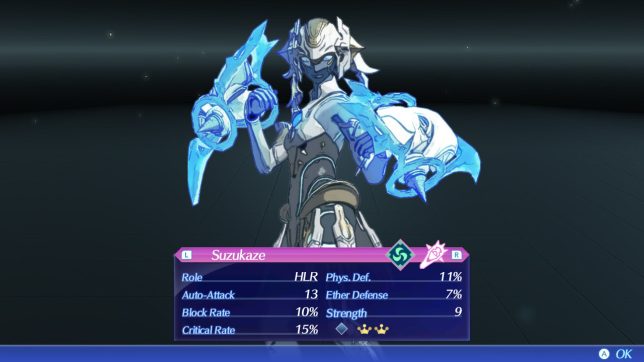
Gambling, but the prizes are sentient, living beings. In the context of the game it’s a lot less horrible than it sounds, I promise. But it still has its problems…
To give a brief explanation of what “Blades” are, they are mystical living beings that embody the power of a particular type of weapon and a particular element. Blades manifest when objects called “Core Crystals” are brought into resonance with a person’s soul. They grant their partner, called a “Driver”, special abilities to perform in and out of combat, and are an essential mechanic of the game. Your party consists of a number of different characters, most of whom are Drivers and therefore can bond with Blades. You can have a very large number of them in each character’s roster, but can only “equip” up to three at any given time. Still, bonding many Blades is encouraged so that you may diversify the number of elements available to you in combat and the number of weapons (and therefore battle skills) available to each party member.
Trouble is, 99% of the Blades you obtain in this game are gotten from the randomized, gachapon-style Blade pulling system. As you play the game, you will obtain consumable Core Crystals of various “rarities”, which you can choose to “bond” to a particular party member. Once you do so, one of two things will happen. You will probably get a randomly-generated “common” Blade whose stats, weapon type, elemental affinity, and other attributes are completely random. Or, once in a while, you may get a “rare” Blade, whose statistics are predetermined, and features a unique design made by one of many famous Japanese manga/anime artists. As their title implies, these rare Blades are quite rare, and the chances of getting each one is based on many random factors, such as the resonating Driver’s luck stat and the rarity of the Core Crystal used. Your thoughts on gacha-like systems may vary, but the trouble with this implementation is that only one of each rare Blade can be present at a time, and each Blade is locked to the Driver that bonded with them.
This becomes a slight issue when a Driver pulls a Blade that does not synergize well with their play style or stats, such as an attacking Blade being given to a character who specializes in being a tank, or a slow and tanky Blade being given to a fast-paced attacker character. To be clear, this is not a deal-breaker, and you can make basically any Blade work with any character during the course of the main game. Heck, you can even beat the whole game using mostly common Blades if you want: speedrunner “Enel” made an entire video challenging himself to do just that. BEWARE: Since the video covers a full playthrough of the game, it naturally includes copious spoilers, but click here if you’re curious.
However, if you are having trouble getting used to the combat system or want to fight any of the game’s numerous optional super-bosses, you’ll want every advantage you can get. Unfortunately, the only method to swap a Blade to another Driver is a consumable item that comes in strictly limited quantities. Your only other option is to discard the rare Blade from your party entirely and hope that the RNG gods play in your favor and grant you the same Blade again, but on the Driver you want. All the while, you’re filling up your inventory with common Blades whom you’ll need to periodically discard en masse (which is pretty messed-up if you think about it, but let’s suspend our disbelief here; it’s a game mechanic first and foremost). All that it would take for this system to be somewhat amended would have been to allow the free switching of non-story-important Blades between party members. However, I suppose that could potentially disincentivize creativity and flexibility in how you build your party. All in all, the Blade system is not the biggest problem in the game, but it’s certainly bothersome at times.
Good: The Characters, Story, and Lore
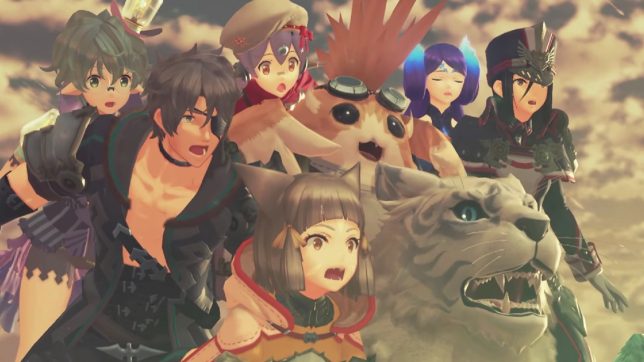
Man, what a bunch’a jokers!
There’s a lot I could talk about here. Part of me wants to go into great detail about all the various characters, villains, allies; to discuss the lore of each country in depth, as well as the lore of the world overall and the conflict at the heart of this game’s story. But the more I think about it, the more I am reluctant to spoil such things for those who might seek to use this review to determine whether they want to play this game themselves. So I’ll try not to explain TOO much, while still touching on the major points that I love. Be forewarned: I am going to be spoiling the names and general info of most major party members. Also, while most party members can summon arbitrary amounts of other Blades to enhance or modify their behavior in combat, I’ll be discussing their fighting style using only their primary starting Blade for simplicity.
Your party could be described (for the most part) as a band of misfits. Rex, the main character, is an orphan working the rather unusual job of a salvager. He dives to the depths of the cloud sea to haul up long-lost containers and other valuables from shipwrecks or long-dead titans, and sells the goods to send home money to his adoptive family in Fonsett Village of Leftheria. All the while, he ponders the tenuous lifespan of the titans that everyone lives on, and the origin of the artifacts from long-lost civilizations he discovers in the deep. He’s a staunch optimist and can be quite idealistic in his views, but he also has a very deep and contemplative side. In combat, he’s your classic fighter class, capable of wielding the power of the Aegis Pyra to deal damage and mostly stay out of trouble in a scrap.
Nia is a Gormotti Driver who, down on her luck, found herself among the ranks of Torna, an international terrorist group. Though she does join up with you a short ways into the story, it’s clear that she’s been struggling internally to find a place she truly belongs. In combat, however, she fits right in, functioning as a solid healer capable of keeping your team in tip-top shape. Her quick but low-power attacks mean that while she doesn’t deal a ton of damage, she can usually avoid being targeted by enemies; a good quality for a healer to have. Nia is probably my favorite member of the main cast, due in no small part to her lovably feisty attitude and Welsh accent.
Tora, a young Nopon inventor, joins Rex out of an admiration for his ability as a Driver. Since he lacks the potential to summon Blades himself, he fights alongside his robot companion, Poppi. He can be rather weird at times, especially with his occasional fascination with maids and the Japanese concept of “moé“. However, he’s a determined and effective team member nonetheless, and is capable of both great defense and surprisingly potent offense. He and the next character in the list are alternating mainstays in my party at nearly all times; a good tank is very important for the lifespan of your team!
Mòrag, the Special Inquisitor and second-in-command to the emperor of Mor Ardain, is a disciplined and distinguished fighter, and fiercely loyal to her nation. She first engages Rex and his party as an opponent, but later becomes swayed by his noble mission to seek out Elysium and end the imminent war over dwindling land and resources; an issue that Mor Ardain feels the most strongly. As her military prowess would imply, she’s a phenomenal asset to your team by acting as a high-agility tank who prefers to dodge attacks altogether rather than blocking them. She’s also got my vote for coolest character design in this game by a landslide.
Speaking of cool characters, we have Ozychlyrus Brounev Tantal, better known as Zeke von Genbu, or preferably…The Zekenator!!! He’s a goofy, lovable dork, and the prodigal prince of the isolationist country of Tantal. If you’re familiar with the Japanese concept of “chūnibyō” then you’ll kind of understand his deal. He basically acts like some kind of overly-dramatic, superpowered badass (and he is), but his flamboyant and ostentatious attitude often means people don’t take him seriously when they ought to, and his cartoonishly bad luck doesn’t help matters. When he’s not being steamrolled by a rock or falling off a cliff, he’s actually a rather intelligent and thoughtful individual whose many travels around the world have granted him insights and wisdom that are truly befitting of a prince. Not only that: he’s a damage-dealing powerhouse in combat, but you’d better keep the enemies occupied with someone else. While he can certainly dole out the pain, he struggles at withstanding it in turn.
As for the villains…gosh, there is so much that I want to say! But a lot of that would be spoiling the great storytelling in the game, and not to mention, I don’t think I could really summarize it properly. The story is huge, and every single chapter you will learn more about the secrets of the world, the motivations behind why the villains do what they do, the tangled web of complexity that has ensued because of the events of the Aegis War that occurred five centuries ago, and how Rex finds his own answer to all of the problems and decides to forge a new path for humanity. Please trust me when I say that the lore behind each of these characters runs deep, and while the villains are absolutely evil in many regards, none of them are completely irredeemable. Each one of them has their own legitimate, if extreme, justifications for what they’re doing and why. Suffice to say, the villains in this game are perhaps one of, if not THE most compelling aspect of the story. And I think the best way to truly understand it, is to experience the story for yourself.
Bad: The UI
Perhaps my second biggest gripe with this game is its user interface. For the most part it’s functional and stylish, but there’s still room for improvement. The most obvious issue is how sluggish the menus are to open and close. Opening or closing the main menu or fast-travel/map screen takes about two seconds, largely because the game performs a fade-out and fade-in transition. Not only that, but after returning to the game screen there’s another second or two of delay before you can open a menu again, during which the game simply plays a buzzer-like sound effect, as if it’s trying to tell you “slow down, I can’t keep up!” While it might seem like I’m nitpicking, you use the menu system in this game extremely often to check on your Blades’ status, unlock new abilities, equip new gear, set pouch items, check on quest objectives, look at the map, and much more, so these delays add up quickly. Additionally, if you’re used to other modern RPGs, you might be accustomed to pressing the “X” button to open the menu. In Xenoblade Chronicles 2, that opens the fast-travel screen; a welcome shortcut to be sure, but if you didn’t mean to open it, now you have to wait what feels like an eternity as you back out of that menu, wait for the main game screen to fade in, wait until it has caught up and lets you open the proper menu with the “plus” button, then continue sitting around as it fades in. It really messes with my muscle memory from so many other games, and every time I made that mistake, I was acutely reminded of just how unsatisfyingly slow it feels. Mind you, navigating within the menus feels snappy enough, it’s really just the transition and loading period that needed to be sped up.
Beyond the menus, another major problem with the UI involves exploration. Namely, the map can be hard to comprehend, and the compass is borderline useless. This game features expansive, multi-layered terrain, but the map condenses the entire area down into a single-layer top-down view, with only subtle shading differences denoting depth. This makes determining where an objective is located on the map very difficult when it’s anywhere that has a lot of depth and various layers crisscrossing over each other. Not helping matters, the game features a compass with markers that display your current distance from an active quest or main story objective. This would be quite handy…if it actually gave a decent indication of which direction the objective was located. Instead, the marker simply slides left and right as you look and move around, sometimes appearing to be straight ahead of you and then veering sharply to one side. Even when you seem to have closed in on the objective, there is no indication of whether it’s above or below your current altitude aside from the fact that you can see you’re standing right on top of the marker on the map, but the number on the compass shows you are still a large distance away from your destination. It’s almost hard to describe how confusing it can be to navigate with these tools, because the way they behave feels unintuitive and illogical at their worst. It isn’t a constant problem, since most of the time your destination is mostly straightforward, but it can make discovering new sidequests or completing them needlessly frustrating at times.
A final issue I have with the UI is how certain statistics or values aren’t explained properly. In particular, when viewing a Blade’s information, there is a field called “Strength” which is completely misleading. It’s nestled right next to other battle-related information like critical hit chance, block chance, defense; but it has nothing to do with their damage or attacks, at least not directly. This stat corresponds to how many nodes on a Blade’s Affinity Tree you’ve unlocked, which I’ll talk about more in a later section. The name isn’t strictly incorrect, because unlocking nodes on the Affinity Tree does generally improve that Blade’s stats and overall battle capability, but…could the developers have at least chosen a less confusing name? Not helping matters, most battle-related statistics and attributes don’t have descriptions at all. While most of them are self-explanatory or easy enough to infer, it still opens up the potential for confusion like this. Speaking of which: if you’re looking for a Blade’s actual attack strength, you’ll find it on the same screen, called “Auto-Attack”…which is also incredibly misleading! Auto-attacks are the most basic, weak attack that your character performs automatically against enemies when near enough, as the name implies. However, this stat determines the power of all that Blade’s attacks, because all attack damage calculations use the auto-attack stat as a base! Again, the name for the value isn’t wrong per se, but why is it named in such a way that obfuscates its purpose and importance? It’s entirely conceivable that a player might not bother buying new equipment or weapons to boost this value regularly because they think it’s unimportant, and become confused and frustrated as the game progresses because they are doing absolutely pitiful damage to enemies!
Good: The Side Content
Big, open-world JRPGs often feature copious amounts of sidequests, and the Xenoblade Chronicles series is no different. The first game, in my opinion, has equal parts good and lackluster side content. While some of its quests are engaging and feature their own storylines (such as the absolutely zany chain of sidequests where you uncover and bust a Nopon drug cartel), plenty of other sidequests in that game are as generic and filler as they come. Each major town in the game features an NPC who unloads three or four sidequests related to gathering items or killing monsters without any fanfare. Xenoblade Chronicles 2 improves on this significantly by tying every sidequest to some kind of plot line, no matter how small. While the objectives of the quests are generally similar, the addition of a plot to keep things interesting adds an additional layer of intrinsic motivation for the player to complete them, and it’s a welcome change in my book. And if you’re not interested, you can always just mash through the text boxes or skip any cutscenes.
What’s more, every rare Blade in the game features their own dedicated sidequest, complete with a more elaborate plot, and often a fair bit of voice acting as well! These quests are often much more involved, and aside from one specific quest that the community generally agrees is borderline un-bear-able (if you get why I made that pun, you probably know the quest I’m referring to), these are all fantastic, and it’s a shame that you need to deal with the whims of the gacha system if you’re determined to see them all.
Furthermore, an amazing thing that Xenoblade Chronicles 2 implements is the “Bonus EXP” system. In many other JRPGs with lots of side content, if you decide to tackle most or all of that additional stuff, you’ll find that you gradually become more and more overpowered. The reason is usually twofold: because you’re bound to earn lots of fancy equipment and items as rewards, but also because doing all of this usually means you’re fighting lots of additional enemies and therefore gaining extra experience points. To combat this issue, any EXP gained outside of combat, be it from exploration or completing sidequests, is not immediately granted to your party. Instead, it’s kept in a separate pool of “bonus experience” for each character that you can draw from to raise their level at inns and other rest stops across Alrest. If you feel like combat is a decent challenge, you can leave this EXP completely alone and never touch it, relying on new equipment and the natural level-ups from combat to keep your party up to snuff. However, if you are having a hard time or would simply like to make things a little easier, help yourself to what are effectively “free” levels that you’ve earned by simply playing the game. This is such a smart design that helps ensure that the game’s difficulty can be balanced towards a variety of play styles, and I really want to see it in more RPGs.
(Side note: If I ever get around to doing a review of Xenoblade Chronicles 3…oh, boy. That game does the most incredible thing that I have seen a JRPG dowith its side content. Especially the DLC story campaign…)
Kinda Bad: The Character Designs

Okay, this is a very subjective topic, and although I was eventually able to move past it, it certainly bothered me for a while when I first started playing. To put it bluntly, many of the female rare Blades in this game—including almost all of the story-important ones—sport large breasts and skimpy outfits. Even if you have no problem with those kinds of character designs, it’s such a prevailing trend in this game that it feels a bit ridiculous, and I find that it can be distracting from the often emotional and serious nature of the game. I think that this dichotomy of design may have been partially due to the decision to commission a ton of popular manga/anime artists to create the various Blades, but it’s still a very odd situation.
At the start of Chapter 2, Rex wakes up in the Gormotti forest after narrowly escaping death at the hands of the villain group, Torna. We are greeted with a scene of him opening his eyes from a first-person perspective, sitting in his Blade Pyra’s lap. The camera stares up at (even focuses on!) her breasts, as though Rex is about to realize what he’s doing and become rapidly flustered and embarrassed. Instead, Rex says nothing; he doesn’t even react. It’s like he doesn’t even notice he’s waking up to an eyeful of cleavage. When I saw this scene for the first time I laughed out loud at the sheer absurdity. It wasn’t even acknowledged! As though these showy character designs were a complete and utter afterthought, shoehorned in for some lewd eye candy. It genuinely feels like this scene was planned out before Pyra’s character design was finalized or something. That isn’t to say that it’s always better to lampshade obvious fanservice, but this plays out like Monolithsoft couldn’t decide on whether this was a serious moment or a lewd one. I really don’t know what to make of it, and it certainly doesn’t help the game trying to make a good set of first impressions.
To the game’s credit, scenes like this are thankfully extremely few and far between once you get past the opening hours, and hopefully it’s something you can look past to appreciate the rest of the game. However, you will need to get used to Pyra having a massive chest and booty shorts so revealing I’m surprised this game got a “T” rating. Oh, and I think the developers got a lot of feedback about this subject, because in Xenoblade Chronicles 3, we actually have a ton of really good female character designs that don’t seem to be all about showing off skin and jiggle physics.
Very Good: The Combat System
A quick-ish showcase of how crazy and fun the combat can get when you get a feel for it. I dealt over 200,000 damage with that Smash attack Rex did!
Xenoblade Chronicles had a very unique combat system that felt like an attempt to implement MMORPG-style battle mechanics into a single-player setting. It worked relatively well, and the second game’s combat feels like a rethinking of that idea. Your character has access to three abilities called “Driver Arts” per Blade they have equipped (up to a maximum of three Blades), as well as a super-powerful move called a “Special” related to your Blade’s element that gradually powers up as you use Driver Arts. This combat style—much like its predecessor—takes a fair bit of time to learn and master, and it can feel very sluggish at first. The key components to making battles flow (and feel awesome!) are Fusion Combos and Pouch Items. I could break these down step by step but there’s this fantastic (and spoiler-free) video by chuggaaconroy that explains what you really need to know to get the most out of this game:
Another key component to gaining an advantage in combat is using Chain Attack overkills to gain bonus money and EXP. You don’t unlock Chain Attacks until partway through Chapter 3 of the story, but once you do the game really gets going. By killing an enemy in the midst of a Chain Attack, any remaining damage dealt to them before the chain ends will start slowly multiplying the experience points and gold you earn from that enemy. If you manage to do this against an enemy with already-big rewards, like a boss or other strong monster, you’ve got yourself an efficient way to both take them down and ensure that your party remains powerful enough to continue dominating in combat. And of course, maxing out a Chain Attack (called a Full Burst) is something that doesn’t happen very often, but is absolutely satisfying to pull off if you can manage it. By the end of the game, my chain attacks were reaching damage into the millions. If you have a fear of large numbers, this method of attacking may not be for you!

The scary thing is, there’s just enough room for an extra digit in the damage section…I can only imagine what speedrunners can do.
To make a long story short, once you understand the combat mechanics and have unlocked some more skills that help things move better, you’ll be starting combos and chaining attacks together at a breakneck pace, and battles will not only feel incredibly satisfying, but earn you extra rewards and help keep you in top form for the battles to come.
Meh-meh: A (Not-So) Short Compilation of the Things that are Both Good and Bad
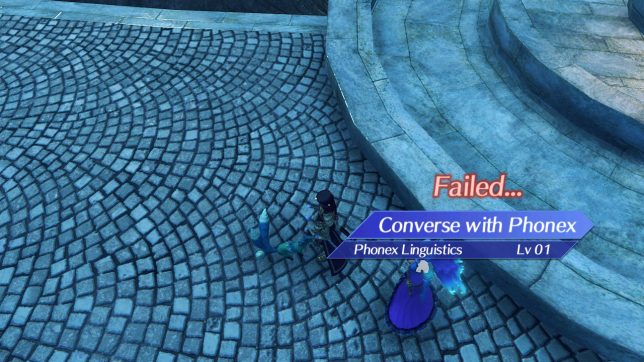
If you’re not keeping on top of your Field Skills, this is gonna happen a lot. It’s a cool system in theory, but not amazing in practice.
Exhausted yet? Well, before I wrap things up, here’s a series of rapid-fire examples of things that are worth mentioning, but don’t need a whole section. These are mechanics that may not be explicitly bad design or frequent sources of annoyance, but can still cause occasional frustration or might have a sub-optimal implementation:
Affinity Trees: Each Blade in your roster, rare and common, has a fancy multi-tiered tree of upgrades and improvements to their skills and abilities that they can unlock. Each “node” on the tree has specific conditions needed to unlock it, such as killing some amount of a specific monster species, completing a particular sidequest, dealing greater than a certain amount of damage, collecting a specific kind of consumable item, and much more. For the most part this system is fine, and many objectives can be completed without any significant grinding. However, for whatever reason, although the game gives you quick popups when you’ve completed one of these unlock objectives, you actually have to open the Affinity Tree screen for that Blade in order for the upgrades to actually take effect. This is really unintuitive and isn’t explained to the player, meaning it’s entirely possible for someone to play through large portions of the game without unlocking one or more upgrades that they’ve rightfully earned.
Field Skills: Amongst each Blade’s abilities are three “Field Skills”: particular things that they can do when interacting with certain objects or people throughout the world of Alrest outside of combat. For example: a fire-element Blade might have the skill “Fire Mastery,” which when combined with the “Wind Mastery” skill of another Blade could help burn up a fallen tree blocking your path. Only the Blades you have currently equipped to your party members can contribute to these skill checks, and upgrading the Affinity Tree for each individual Blade will increase the “level” of their skills in order to meet the criteria of more demanding obstacles. If you’re strictly following the main story, you won’t find too many of these obstacles, and the ones you do find will be relatively easy to overcome. However, if you like exploring these vast regions and investigating every nook and cranny, you will come across many Field Skill obstacles that require you to rearrange your equipped Blades or potentially go out and grind for upgrades on their Affinity Tree, which can be tedious or even impossible at your current progress in the game. On the bright side, however, attempting and failing at a Field Skill check will permanently mark it on your map until you manage to succeed, so it’s just as well if you want to leave and try again later.
Merc Missions: These are unlocked halfway through the game, and serve as a way to put your large backlog of Blades to use. You send them off on various unattended missions that might net you a modest amount of gold, rare items, or even add new entries in the stocks of various shops around the world. Not only that, but Blades dispatched on these missions will sometimes return with one or more nodes on their Affinity Tree unlocked, providing another avenue to fill that out if you don’t want to go around completing the objectives manually. One minor gripe, however, is that these missions take varying amounts of real-world time to complete. This timer does tick down while sitting in menus and the like, but it does not progress while the game is suspended or your Switch is asleep: the game needs to be active and running. Given that some sidequests and even Blade abilities may be locked behind completing a specific number of Merc Missions, you’ll want to keep some kind of mission active at all times as you play the game, to ensure you’re maximizing your productivity behind the scenes. Or, y’know, you could also just send off a mission team and then just leave your Switch idling on the charger while you go do other things. I won’t judge.
Poppiswap and “Tiger! Tiger!”: One particular character you meet early on is Tora, a Nopon who has built himself the world’s first artificial Blade in a quest to become a Driver despite not having the ability to resonate with Core Crystals. This Blade, Poppi, has her own completely different system for configuring her abilities and skills in addition to the Affinity Tree: the aptly-named Poppiswap system. She is an incredibly versatile and flexible party member, being able to change battle roles and even elemental affinities by simply selecting components from a list. However…all of these swappable components are obtained from a special minigame: an old arcade machine in Tora’s house built by his grandfather, called “Tiger! Tiger!”. In this minigame, you descend in a pixelated 2D cave, fighting off monsters and collecting treasure and Ether crystals, until reaching the mother lode at the bottom and swimming for the surface. The rewards you get from it are randomized, and new levels with better parts unlock as you progress through the main story, so expect to invest quite a bit of time into this little arcade game. And here’s a pro tip: At the start of the minigame, always choose the “easy” mode. There is zero penalty to the bonuses you get from the game, and you don’t take damage when colliding with the terrain like you do in normal mode. Your only discouragement is a period placed after your score in the high-score list: completely and utterly meaningless, not even remotely a reason to play the game in its more difficult mode. Good thing, too; I would have marked it down as its own “Bad” section if you needed to play the harder difficulty!
Very Good: The Music
There is so much I want to say here, but really I find it exceptionally difficult. I have never taken a music theory class, so I lack the necessary vocabulary and knowledge to properly explain why I love this soundtrack so much. But rest assured it is incredible, featuring a variety of compositions spanning many different genres of music, instrument groups, thematic styles, tempos, and emotional sensations. Most areas have a separate theme for daytime and nighttime, adding to the variety and atmosphere. I find myself humming the major area themes very often while at school, work, or on a commute. The day and night themes of the main areas of the game (Gormott, Uraya, Mor Ardain, Leftheria, and Tantal) are all amazing, as are all the town themes, and the various battle themes are as well. Some tracks even feature awe-inspiring choir vocals, such as Theosoir and the Praetorium. And of course, the cutscenes wouldn’t be half as emotionally gripping without a fantastic score to back them up.
I really enjoy the use of the leitmotif introduced in the game’s title theme “Where We Used To Be” in various other tracks throughout the game, which are often brought up in very emotional moments. The game’s ending theme is cleverly based on that same note progression but hides it well until the very last second, where it sneaks in the original piano melody right when you’re contemplating the journey you’ve just finished, and then you realize that “where we used to be” suddenly has a whole new meaning. I’m not ashamed to admit it: I cried in that moment. It was a beautiful capstone to an amazing story, and every time I return to the title screen of Xenoblade Chronicles 2 and hear that melody I cannot help but be overwhelmed by emotions. It’s a powerful story and a wonderful game, complemented beautifully by awesome music.
A Rocky Start: My First Time Playing
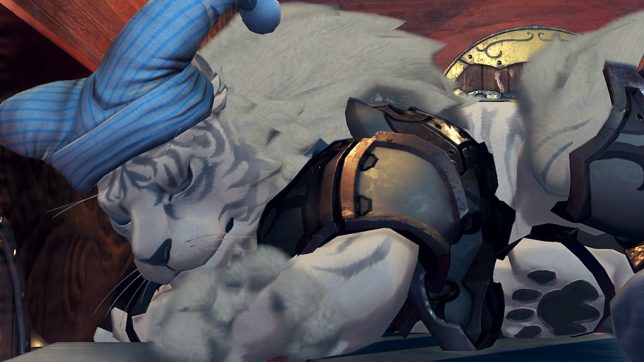
While also indicative of how I didn’t feel particularly enthusiastic about this game initially, I primarily used this screenshot because Dromarch wearing his night cap is absolutely adorable.
When I first picked up Xenoblade Chronicles 2 back in early 2019 or so, I barely knew anything about the Xenoblade Chronicles series at all; I’d only watched a playthrough of the first game on YouTube. However, I’d heard good things about this game and liked what I’d seen of its predecessor, so I decided to take a chance on it. I played on and off for about six or seven hours, but felt disappointed by several factors: the combat felt sluggish, as though enemies had way too much health; I had a very hard time navigating the (admittedly gorgeous) locales I visited; I hadn’t managed to reach a point where the story could truly capture my interest; and the characters—while charming—felt mostly goofy and fell prey to a lot of exaggerated anime tropes, which the game is much more guilty of early on. Had YouTuber chuggaaconroy not happened to produce a comprehensive playthrough/video guide to the game in 2020 out of his sheer love for the game (which was two and a half years of research in the making, by the way!) I would almost certainly have never tried it again. And that sucks! Certainly, plenty of people managed to absolutely love and enjoy this game without any outside assistance. But I was not one of those people, and I’d like to think that it wasn’t for a lack of trying. It really makes me wonder how many people missed out on such a fun and enjoyable game simply because it fumbles at making first impressions.
But enough bemoaning what happened back then; because once I felt like I had the additional gameplay knowledge, development context, and general understanding of what I was getting into, it made all the difference…
When it All Comes Together: The Second and Third Time ‘Round

When I finally sat down to play Xenoblade Chronicles 2 in earnest, I was skeptical, but hopeful. I hadn’t forgotten my woes from my earlier abandoned attempt, but I was also considering the ever-growing praise and advice from my friends and the recommendations of other prominent content creators. And as I’m sure you can tell by this point, this second attempt went a lot smoother.
First of all, there was the fantastic story and compelling characters that I’d been following throughout the entire adventure. Xenoblade Chronicles 2‘s characters had gone from being this goofy and awkward band of weirdos into a lovable and endearing group of friends that I loved hearing interact with each other, and whom I cared about. Perhaps one of my favorite moments that illustrates this is the final section of the cutscene that opens Chapter 7 of the story, where Rex’s idealistic and ever-optimistic attitude suddenly crumbles in front of his friends in an extremely believable and heart-wrenching way. It’s interesting, too, because while Rex initially looks to be your run-of-the-mill anime/videogame protagonist (an average young man with a dream and some secret hidden potential), he and the rest of the cast are all surprisingly deep and human. Watching them all interact and get to know each other along with slowly learning about them as the game goes on was genuinely a reward in itself, just as it is in all the other Xenoblade Chronicles games.
But a wonderful story and compelling characters means nothing without good gameplay to back it up, and while I’ve discussed some pros and cons above, I need to reiterate that once you know what you’re doing, this game feels great. Armed with the proper knowledge of the combat system and other game mechanics, battles felt much snappier; by extension, I felt significantly more capable in the face of strong foes. There were still a couple stretches of the game that felt a bit challenging and tedious, particularly in the final chapter or two. But looking back, I had gotten busy with a semester of college, and I also had a desire to check out other new games that were coming out. To put it bluntly, I was slacking off and not keeping up with giving my party members new and better equipment or keeping their combat skills upgraded. However, the game design was accommodating: I simply cashed out a few levels’ worth of all that Bonus EXP I’d been accruing over my playthrough, and I was good to go again. I’m not positive how much I had gathered by that point in the game, but I probably had about 10 levels of EXP waiting in the wings for me, which in the end-game is quite a lot. All just from completing sidequests and exploring the wonderful world of Alrest. In that sense, the game basically builds its own safety net as you progress. By the time you start to feel a little burnt out, you’ve already unlocked the tools you need to make things easier on yourself and push past that section.
In fact, I began another full playthrough of the game at the beginning of this year, and although I was expecting the journey to feel boring or clunky in comparison to Xenoblade Chronicles 3, I was pleasantly surprised to enjoy it just as much as I always had. And to be clear: replaying huge JRPGs like this is almost unheard-of for me—it’s so much of a time commitment, especially since I’ve already experienced the story once before. Nevertheless, I’ve found the game to be nearly as fun this time around as it was the previous. Trying out new sidequests that I missed or ignored last time, or seeing what I could do differently with my team composition since all of my random Blades were now belonging to different Drivers, and much, much more.
And really, I think that initial false start and all the problems that I found as I played might be what make this game so particularly special to me. The fact that it failed to capture my attention the first time around; the fact that by all accounts it stumbles so hard at making good first impressions that you need some perseverance to push past the opening hours, and yet…when the credits rolled, I had tears in my eyes and a huge smile on my face. Somehow, some way…this game managed to not only turn out to be better than I expected, it turned out to be one of my favorites ever. This game, to me, is the embodiment of the maxim “don’t judge a book by its cover”. For all these reasons, I decided that Xenoblade Chronicles 2 was more than deserving of a review here on GameCola.
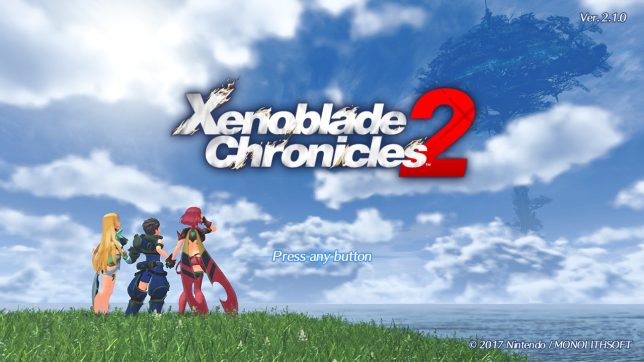
And thus, boy met great game.
Is This Game For You?
Given how much I’ve just sung the game’s praises, this is a more difficult question than it might seem. My heart wants to give this game a 9 out of 10—excellent, almost perfect. While I absolutely love it, as I’ve stated quite plainly it is far from perfect. My perspective is probably one that is biased: I’ve sunk over 120 hours into this game, and felt passionate enough to rant on and on about it in an 8,800+-word long review, and I think that says a lot about how strong my feelings are. As a result, that also probably means that some of the flaws I’m able to overlook are ones that others might not or cannot; I know one or two of my friends feel this way, and maybe you will too. With that in mind, and given my initial struggle when I first attempted to play, I will drop my score by one point, to an 8. Nevertheless, I implore everyone, if you haven’t already, to give Xenoblade Chronicles 2 an earnest try. It is practically the poster child for “don’t judge a book by its cover”. While it has some low lows, it also has some incredibly high highs. If you decide to give it a shot, I really do hope that you will fall in love with this game, just as I did.

Well, it’s my first article in seven years. I said when I posted my first one that I hoped to look back and be proud of how far I’ve come. I’m glad to say that I certainly am. But I’m not stopping here. I want to write more; perhaps not articles this long, but more of them. When? I’m not yet sure. But I will.